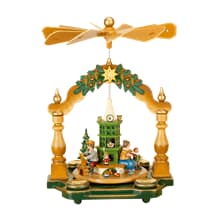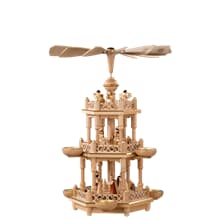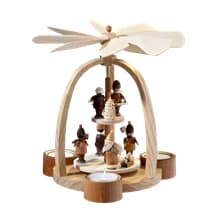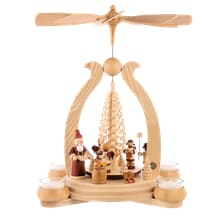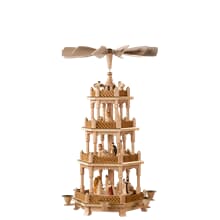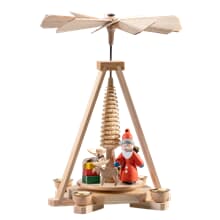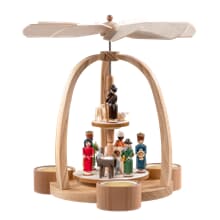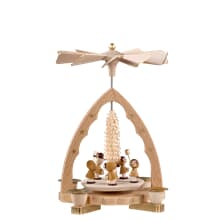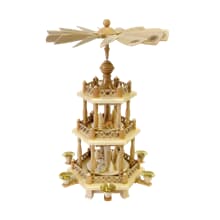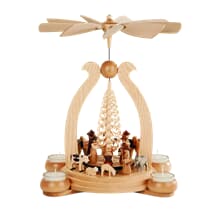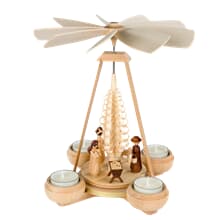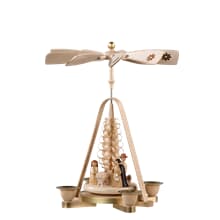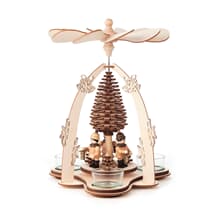Pyramids from the Erzgebirge
When the days become noticeably shorter, the temperatures drop and the year draws to a close, it's that time again: Christmas is just around the corner and the Advent season begins. For the children a reason to rejoice, for the parents a month of busy preparation, for the older ones a time full of memories.
The rooms are decorated for Christmas and many a cherished treasure reappears. It awakens to new life in the glow of lights. Christmas is a wonderful time to remember family history. Pyramids are part of the traditional Christmas decorations. They tell of the many Christmases past, enchant in the present and give certainty to the future.
The Erzgebirge - Home of folk art
Life was not easy for the simple people who lived in the wooded villages and small towns of the Erzgebirge. The hard work of mining had shaped the region and its people. But silver and copper dried up. Ironworks stopped working again and again. Something new had to be created. The industrious little people were inventive and achieved true mastery in the field of wood and toy production, lace and trimmings.
The Erzgebirge folk art became world famous with its incense smokers, candle arches, angels, nutcrackers and Christmas pyramids. They enchanted people all over the world and were soon regarded as the epitome of German Christmas and wooden art. Artful nativity scenes were carved by skilled hands and were soon sought after as works of art.
Many elements from everyday life found their way into the design of the figures, which seem as familiar at Christmas today as they did then. The miner appears again and again and left his mark on nutcrackers and incense smokers.
Christian motifs were designed from the very beginning. They were found as independent nativity scenes and on the pyramids. The many small and large angels have always adorned the Christmas room as standing figures, candlesticks, tea light pyramids and tree decorations.
Typical of Erzgebirge folk art was the work in small manufactories. Many of them still exist today. Every year they delight people all over the world anew with their craftsmanship and their old and yet always very modern Christmas decorations.
German Christmas
Today, people all over the world come together to celebrate Christmas under the festively decorated tree.
The tradition is much younger than some people think. The twinkling Christmas tree has only been decorating Christmas parlours since the last third of the 19th century. It has its origins in Germany. The first Christmas trees are said to have existed in Freiburg around 1420. Their models may have been the decorated trees of the Paradise Games.
The celebration of Christmas is deeply rooted in the festive church services. The decorations of the rural churches with their cherubs and Mary's figures, with the manger and the baby Jesus found their way into Erzgebirge folk art. And soon the chubby-cheeked angels were announcing the birth of the Lord in the parlours of ordinary people too, nativity scenes were found on Christmas pyramids, a miner was placed next to an angel as a light figurine in the window.
Songs like "Silent Night, Holy Night" and "Oh Christmas Tree" were translated into many languages. Together with Christmas decorations, they found their way into many other cultures. Queen Victoria brought the Christmas tree to England and established a German-style celebration at court. The custom, which was cultivated in Windsor Castle, quickly spread. The tree was decorated with precious glass balls, as they are still made in the Erzgebirge mountains today.
The first pyramids
The rotating tree is considered to be a precursor of the Christmas pyramid. The frames were woven from willow rods and decorated with cherry branches, as they are also cut for Saint Barbara's Day.
Inside, there were discs mounted on a central axis, on which small figures from the Christmas story, little apples and gilded nuts as well as candles were attached. The revolving tree was crowned by a sun made of wooden wings. The rising warmth of the burning candles caused the construction to move and the light frames to come to life.
Before the Christmas tree became widespread, fixed pyramid-shaped frames, entwined with fir foliage and fitted with lights, were found in churches, public squares and, in smaller versions, in domestic living rooms.
The Yule log and Candle arch are also distantly related to the tradition of twisted turning trees, but with the turning tree and pyramid the mechanical sophistication is added: driven by the heated air, the impeller turns. To this day, children are fascinated by rotating small and large pyramids and can spend hours watching the impeller go round and round.
In the Erzgebirge, it was probably the Göpel that contributed decisively to the development of the pyramid. This construction was used by miners as a horse-drawn göpel in mining and was used to convey rubble and ore, which made the miners' work easier.
This is how the pyramid shape typical of the Erzgebirge was created, as it is still known today in single and multi-storey form: fixed candles, a rotating central axis with its decorated plate and above all the sun with its wooden wings, the impeller, driven by the rising heat.
Craft perfection with heart and soul
Just as in olden times, it is the small craft workshops that bring the pyramids and figures to life. Artful woodturning has been preserved over the centuries, the shapes have retained their uniqueness, the colours of the painting are characteristics of the figures appreciated by connoisseurs.
Just as in the past, the curls of the small stylised Christmas trees are set during chip tree cutting, creating the popular hoop animals that can also be found on Christmas pyramids. The curly trees decorate pyramid plates or can be found as a centrepiece which the other figures are grouped around.
Only selected woods can be used for these demanding techniques. Straight grown, evenly drawn lime wood is the material from which the little trees and thus high quality wood art are created. It requires a high level of skill to cut the small curls evenly and precisely with the sharp carving knife from the workpiece that has been previously cut to size. None of the curled chips must be damaged.
Often the columns and bars are ornately decorated or even inlaid. In the case of multi-storey pyramids, the structure alone looks imposing and shows the impressive craftsmanship. Large pyramids from the Erzgebirge have adorned public spaces since time immemorial. The precious works of art bear witness to the craftsmanship of the old and young masters. In New York, London and Dubai they find their admirers and are highly traded. But they owe their charisma to the loving production in small, owner-managed manufactories.
Decorating lovingly for Christmas
Advent is the time of waiting and anticipation. Baking and handicrafts are made. Sweet smells waft through the rooms. Mulled wine and Christmas biscuits are ready for gathering with family and friends.
But the Advent season only becomes really atmospheric with the right decorations. When the Advent wreath with its candles stands on the table, the candle arch in the window lights up and old melodies sound from the music box, then Christmas is not far away.
Children marvel at the little figures, Advent stars give off their warm light and the smoking man smells homely. Those who like it rustic will choose colourful tree decorations and also select their pyramid in the appropriate style. Deer in the forest or carol singers suit a happy family celebration.
Erzgebirge folk art can convey mood and also look elegant. Monochrome, stylised Christmas pyramids fit perfectly into a luxurious ambience.
The classic Christmas colours of green and red can be continued in the decorations. Contrasts also have a refreshing effect. Who wouldn't like to have a whole orchestra of angels as guests? After all, Christmas only comes once a year ...
Keeping traditions
There are many Christmas decorations. But Erzgebirge folk art is a living craft. For centuries it has been handed down in the Erzgebirge, experience, patterns and tools have been passed on from generation to generation in the family businesses of various manufacturers. An entire region is named after the craft: The area around Seiffen is called the "Toy Corner". For example, the Christian Ulbricht company, the Kleinkunst Müller company, the Richard Glässer company or the Hubrig Volkskunst company and many other companies are from this area,
What once arose from the miners' hardship and as an alternative to mining found enthusiasts and collectors all over the world. Pyramids from the Erzgebirge are as much a part of Christmas celebrations in many families as the fir tree. They are passed on and carefully preserved just like the craftsmanship of the woodturners, wood sculptors and wooden toy makers.
Erzgebirge folk art is a piece of lived sustainability in an ever more rapidly changing world. It is its own ecology, as it has been lived in villages and small towns for centuries. Attentive and careful in the handling of wood, it has shaped the masters and their families.
Whereas the tyre-turning craft originated in Seiffen around 1900 in order to be able to produce toys efficiently in larger numbers, today the handmade figures and animals are something special when they decorate tea light pyramids or can be put together decoratively as miniatures.
The work of the carvers and turners from the Erzgebirge is protected today. Anyone who buys a product with the "Erzgebirgische Volkskunst" seal can be sure that they have purchased a genuine piece from an Erzgebirge workshop.
Contemplation in your own home
Trends come and go. Interiors change, but the love of traditional Christmas decorations remains. There are the bright poinsettias that greet you from afar. There are the enchanting candlesticks and the candlelight that shines right into your heart.
Many forms of pyramids have been created in the Erzgebirge. Each workshop has its own distinctive figures and light frames. In the factories of some manufacturers, modern, stylised forms have also been added over the years. But the magic that surrounds the Mother and Child and the Magi on their wanderings always remains. The ox and donkey always stand by the manger, the shepherds with their sheep are constantly on the move on the pyramid.
The handwriting of the masters is palpable when looking at the many small details. How carefully the wood was selected, how finely the struts and curves were drawn, how well-balanced the figures were painted and mounted on the rotating discs.
The turning wings and the glowing candles create an interplay of light and shadow. For centuries it has fascinated people and given them a feeling of security. Today, Christmas pyramids are available for classic small candles, for tea lights and even with electric lighting.
Happy family celebration with snowman and crispy witch
What could be better than celebrating Christmas with the whole family? Who is not moved when they look into the beaming eyes of children and feel the almost uncontainable anticipation of the big presents?
The many chubby-cheeked angels with their instruments or a fat round snowman, who cheerfully spins around in circles, are a perfect match. The Kurrende singers set the mood with their own Christmas carols and the Christmas story can be impressively told to a colourfully painted manger. No child will ever forget the names of the Magi after watching them tirelessly follow the star on the family pyramid. Or should it be Hansel and Gretel with the crunchy witch who decorate the pyramid as a motif?
Christmas is the time for family gatherings. It is the time to get together to tell fairy tales and stories by the fireside. While the older ones find a little more to themselves, the little ones enjoy the quiet gatherings, playing together, telling stories and reading aloud.
Mechanical toys have attracted children throughout the ages. Even today, kids look up from their smartphones when they see a steam engine. The pyramid is a small model that is easy to understand and yet never fails to delight. Young and old watch the candlelight and the spinning sun and begin to dream a little.
Every year again and again
Christmas is more than just buying presents. It is a time for reflection. More and more people want continuity and warmth. They find their way back to old handicrafts and learn to appreciate the value of real handicrafts themselves in a whole new way. They want something distinctive, a one-of-a-kind item that is as special as their own lives.
If you want to give your loved ones something valuable, you should pay attention to quality and not orientate yourself too much to the zeitgeist and changing fashions. With a pyramid, he gives away something unique, a piece of happiness that comes back every year and becomes more and more beautiful with the years.
The secret of the pyramids from the Erzgebirge is not only in their construction. It is the uniqueness of the light frames that people feel. Every angel looks a little different. Each little ringed tree has its own character. If you look closely, you will recognise something more in its pyramid every year. Over the years, not only do people grow, but the Christmas pyramid also matures and acquires its very own patina through time and all the many memories.
When the pyramid slowly turns, it warms your heart. Colourful and enchantingly playful or stylised and elegant, the Christmas pyramids from the Erzgebirge bear witness to the craftsmanship of their masters, to their feeling for shapes and colours, to their special ability to bring wood to life. History, tradition and an ever-awake sense for the present make Erzgebirge folk art so special.




